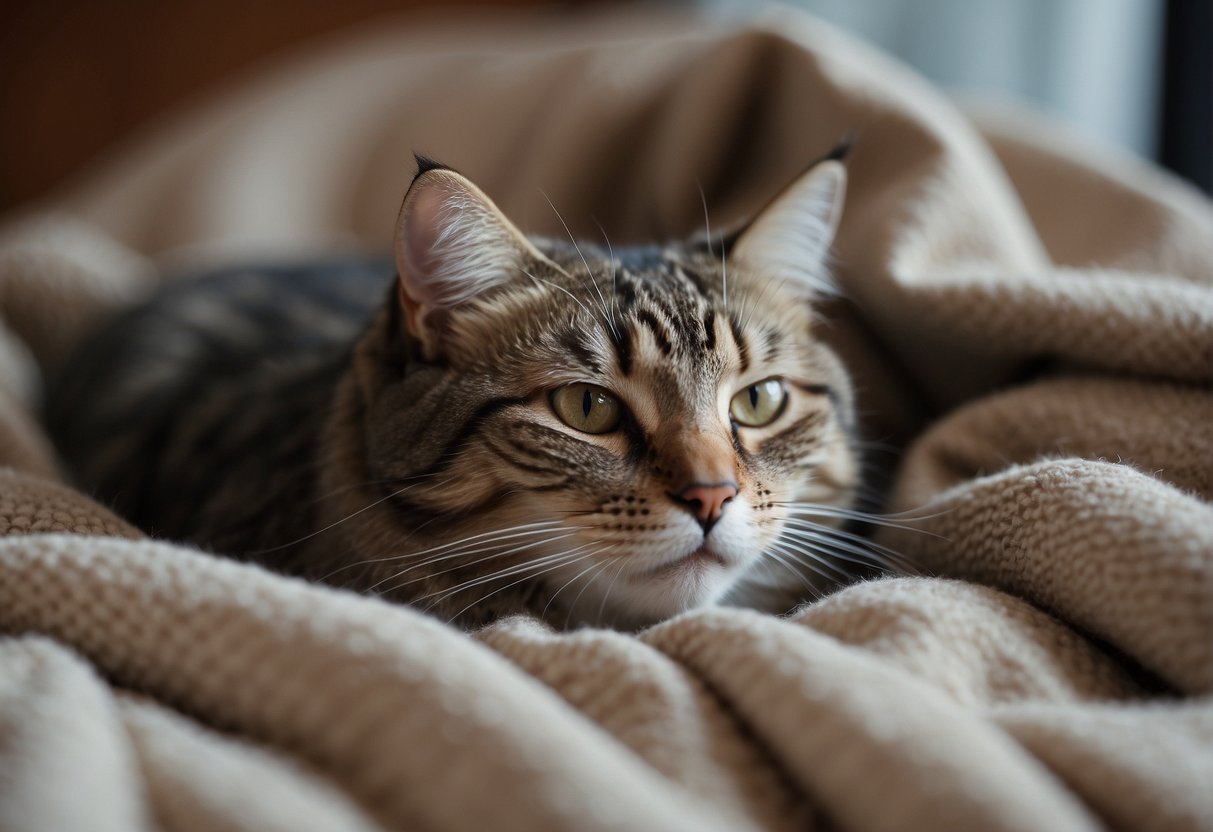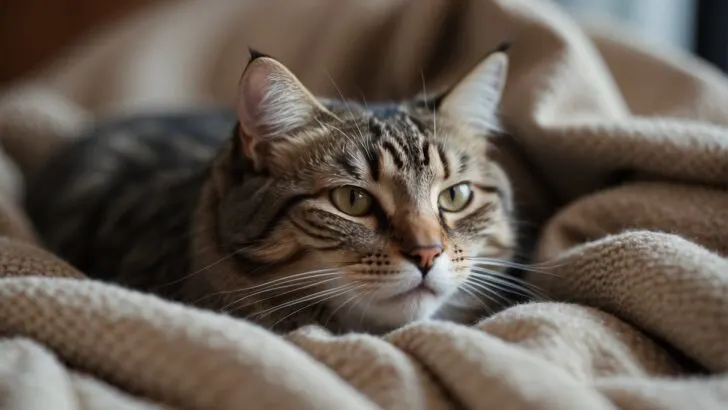Cats suckle for a variety of reasons, and it’s a behavior that can be both endearing and puzzling to cat owners. If you’ve ever found your feline friend latched onto a soft blanket or even your clothing, you’ve witnessed the phenomenon of cat suckling.
This behavior is most common in kittens, who nurse from their mother for nourishment. However, adult cats also retain this kitten-like behavior, often suckling on soft objects as a source of comfort.

Suckling can be traced back to a cat’s earliest days. For instance, you might notice your kitten begins to knead and suckle as they settle into their favorite sleeping spot.
It’s a habit that’s rooted in the nursing actions they used to stimulate their mother’s milk flow. As a cat owner, you might have observed this behavior when your cat is feeling relaxed or seeking attention, providing insight into their emotional state.
Cats’ suckling behavior can be puzzling, evoking questions about its origins and implications.
The Science Behind Suckling
Suckling is a natural instinct that begins in kittenhood. For kittens, it’s a source of nourishment and comfort, as endorphins are released during suckling which have a calming effect.
But it’s not just about survival; it’s an embedded behavior that can carry over into adulthood. This behavior is often a response to comfort-seeking behavior that was learned during kittenhood.
Suckle Triggers and Feline Breeds
Some cats, particularly those separated early from their mothers or bottle-fed, may be more prone to this comfort-seeking behavior as adults.
Specific feline breeds may exhibit these behaviors more frequently, especially oriental varieties such as Siamese or Burmese, which might have a genetic predisposition to such compulsive behaviors.
- Triggers for Suckling can include:
- Stress
- Boredom
- Separation anxiety
- Desire for comfort

Cat Suckling vs. Nursing Behaviors
It’s important to differentiate normal suckling from nursing or more problematic behaviors like pica, where cats eat non-edible items.
Suckling is generally a benign comfort action, where an adult cat may repetitively suck on soft objects, fabrics, or even their owner’s skin without causing harm. In contrast, pica and other obsessive-compulsive behaviors can be harmful and may require veterinary intervention.
Why Cats Continue To Suckle
Cats may continue suckling long after their kittenhood for a myriad of reasons, stretching from emotional needs to the simple physical pleasure it provides.
Emotional Factors Influencing Suckling
Sometimes your cat continues to suckle because it’s looking for a way to deal with stress or anxiety. This self-soothing behavior is akin to a coping mechanism that helps them calm down and feel secure.
Early weaning or separation from their mother can also lead to suckling in adult cats – it’s a sort of security blanket they carry into adulthood. Think of it as a way to return to the carefree days of kittenhood, when they felt the most content and protected.
- Separation Anxiety: If you find your cat clinging to your favorite sweater and suckling away, it might be experiencing separation anxiety, especially if this happens when you’re away.
- Trauma: Suckling can also be a response to past trauma. Like a fuzzy form of therapy, cats may suckle to comfort themselves when something reminds them of a less pleasant time in their lives.
Physical Comfort Derived From Suckling
The act of suckling releases endorphins in your cat’s brain, akin to a person taking a relaxing hot bath.
It’s soothing and calming, offering both physical comfort and a sense of relaxation.
Cats may knead and suckle soft materials because it feels good—like a built-in spa session.
- Compulsive Disorder: On occasion, the behavior can border on a compulsive disorder if it appears to be incessant and disrupts normal activity.
Suckling in Multi-Cat Households
In homes with more than one cat, you may witness suckling as part of their bonding rituals. It’s not just about comfort, but also about forging connections between them.
- Bonding: Felines in multi-cat households might exhibit mutual grooming, and suckling might be a part of this shared social behavior.
Potential Issues and Solutions
Cats suckling can be endearing, but it may also signal issues that need attention. We’ll explore when to be concerned, what underlying issues may exist, and how to potentially modify this behavior.
When Suckling Becomes a Concern
If your cat’s suckling habits seem excessive or are accompanied by changes in behavior, it could indicate underlying health issues or stress.
Signs to watch for include suckling on objects, other animals, or themselves for prolonged periods, which might lead to sores or infections.
Frequent and intense suckling that escalates to aggressive biting or chewing can be cause for concern, necessitating a veterinary examination.
Approaches To Modifying Suckling Behavior
To modify your cat’s suckling behavior, consider the following:
- Environmental Enrichment: Make sure your cat’s environment is stimulating and relieves boredom. Provide toys, scratching posts, and interactive play.
- Positive Reinforcement: Use treats and affection to reward your cat for ceasing the suckling behavior.
- Diversion Tactics: Redirect your cat’s attention to more appropriate activities when they begin to suckle.
- Consistency: Maintain a consistent routine to reduce anxiety that might lead to suckling.
Remember, abrupt modifications may lead to further stress, so any behavior modification should be introduced gradually.
Providing a secure and harmonious living space is crucial in helping to manage suckling driven by compulsion or stress, potentially reducing the occurrence of obsessive-compulsive behaviors.
Enrichment for Suckling Cats
Cats that engage in suckling behaviors can benefit significantly from a variety of enrichment strategies which address their need for mental stimulation and comfort.
The Role of Play and Attention
Consistent playtime is essential for diverting your cat’s suckling behavior towards more appropriate activities. Dedicate time to:
- Interactive Toys: Use wand toys or lasers to engage your cat’s hunting instincts, providing both physical and mental stimulation. Such playtime can reduce distress and boredom.
- Quality Time: Regularly schedule periods where you can give undivided attention to your cat.
Environmental Enrichment and Comfort Measures
Creating a cat-friendly environment can greatly reduce comfort-seeking behaviors like suckling on objects, fingers, or fabrics.
- Cozy Spaces: Establish designated sleeping areas with soft bedding or cat trees where they can retreat and feel secure.
- Scratching Posts: Include scratching posts to allow for a natural outlet for scratching behaviors. This can be therapeutic.
- Puzzle Toys: Introduce puzzle feeders or toys to keep your cat’s mind engaged. This helps prevent boredom and provides necessary mental challenges.
- Comforting Scents: Employ products like Feliway diffusers in your home. They release synthetic pheromones that can have a calming effect on cats.

My name is James, and welcome to FAQCats!
Along with our team of cat owners, expert pet enthusiasts, and pet professionals, we aim to write engaging helpful, engaging content about cats. At FAQCats we strive to provide content that’s accurate and fun to read. Our team writes about everything related to cats; even the most complex of topics. Through extensive research and caring for our own fur-pals, we’re able to provide something cat owners worldwide will love. Have a look around, and leave us feedback anytime!

